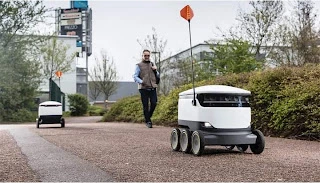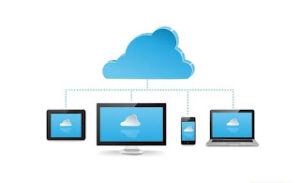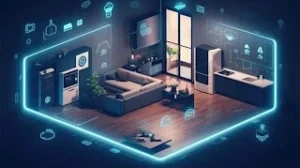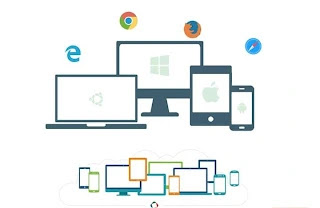When hearing the word ‘robot’, many people think of a large humanoid machine made of metal or shiny metal objects. Many people think that robots will enslave mankind in the future.
However, one thing is certain that robots are the future of the world. There are some differences with the future world shown in the movie. So far it is hoped that robots will not usurp human power or take away the highest positions. Rather, they will continue to perform dangerous and monotonous tasks perfectly, which will help improve the quality of human life.
The use of robots is not limited to increasing factory productivity. Robots are playing important roles in health, agriculture, transportation and supply chains, space exploration, and even education.
Artificial intelligence (AI) serves as an important component of robots, making them more autonomous and efficient. Robots are now able to make decisions and perform various tasks automatically, making our daily lives easier and more convenient.
This article has a detailed discussion on what robots are, the role of artificial intelligence in robots, its future and how robots will change our lives. The rapid development and widespread use of robot technology is opening up new possibilities in every aspect of our lives.
What Is Robotics?
Robotics is a branch of engineering or engineering that deals with the concept, design, construction, operation, application and use of robots. A robot is generally defined as an automated machine, which can perform specific tasks independently.
Robots don’t need to be humanoid. Although some robots look like humans. Robots that look like humans are commonly called ‘androids’.
Robot designers like to make robots modeled after the human body so that people feel more comfortable around the robot. But that may not always be the case. Some people fear robots, especially robots that look human.
Different Types Of Robots
Robots are versatile, multitasking machines. This is proven by their variety of sizes and working capabilities. Nowadays, different types of robots are seen in different fields. For example:
• Robots in healthcare
Robots assist in various tasks in the healthcare sector. Robots assist surgeons in surgery with great precision, enabling complex and delicate surgeries to be performed with greater precision.
Robots for physical therapy assist patients in a variety of exercises and therapy activities. Robots are also used inside hospitals to transport patients from gate to room, deliver medicines or other necessary equipment.
Especially during pandemics, such as the coronavirus outbreak, robots play a huge role. They help reduce the risk of infection to hospital staff and maintain continuity of services. Robots are also being used in factories manufacturing ventilators, which have played an important role in saving lives during this pandemic.
• Robots in the home
Robots in the house are no longer a sci-fi story. They are actually becoming a part of our daily lives. Robot vacuum cleaners are very helpful in keeping our house clean. Once charged, they can automatically clean dirt, dust and pet hair from floors or carpets.
Also becoming popular are lawn mower robots, which automatically complete the task of mowing the garden. All you have to do is program them, then they start working according to the specified time.
• Robots in manufacturing
The first and major use of robots began in the manufacturing sector. The use of robots as machines in automobile assembly lines was the beginning of the robotic revolution in this sector. Today, industrial robots are capable of performing a variety of complex tasks easily and efficiently.
Industrial robots are now performing tasks like arc welding, material handling, steel cutting, and food packaging with high precision. In arc welding, robots perform joint work quickly and accurately, which can be cumbersome and dangerous for humans. In material handling, robots move heavy and complex objects and deliver various machinery parts inside factories.
The use of robots in steel cutting and other metal processing has increased tremendously. They are capable of working in high temperatures and hazardous environments, which can be dangerous for human workers. In food packaging, robots accurately fill food packets, helping to maintain food safety and quality.
The use of robots in all these tasks is not only making the production process faster and more accurate, but also reducing costs and making the working environment safer for workers.
• Use of robots in education
Robotics technology is now making a huge impact in the field of education. A variety of robots are enriching the learning experience of students and making the teaching process more effective for teachers.
Children can learn about programming and mechanics from an early age with educational robot kits and programmable robots. These kinds of robot kits give students hands-on experience, which increases their interest and focus on learning. For example, platforms like VEX Robotics help kids build robots and learn programming.
Through virtual reality robots and other interactive robot platforms, students can gain real-life experiences. Such technology helps students learn subjects like science, math, and history in a more engaging way. With virtual reality robots, students can see and learn about Earth’s history, the wonders of space, and other complex topics through 3D visualization.
Through robotics, students also gain a variety of social and practical skills, such as teamwork, problem-solving skills, and creative thinking. Through this technology, students learn to apply their ideas in practice, which is important for their future.
• Use of robots in agriculture sector
A variety of agricultural robots are now being used to plant, tend and harvest crops. For example, automatic tractors and crop planting machines greatly assist farmers in their work. Such machines can automatically cultivate the land and sow the right amount of seed at the specified time.
More advanced technologies include drones, which monitor crop health and apply the right amount of fertilizer and pesticides at the right time. Drones fly over crops to take pictures and analyze them to determine the crop’s health status. This enables farmers to take the right action at the right time, which helps in increasing crop production.
In addition, some robots are capable of automatic weeding and tending to crops. They identify weeds for specific crops and remove them so that crops can grow well.
The use of robots in the agricultural sector is not only increasing crop production, but also reducing human labor in agriculture. As a result, farmers can save their working time and focus on other important tasks. Also, robots are making better use of land, which is also having a positive impact on the environment.
• Robots in the transport and logistics sector
Every entrepreneur or business wants their online orders to be delivered on time. In this case, warehouses are employing robots to pack products, locate and prepare products for delivery, and even deliver short-range products.
In warehouses, robots move and sort products very efficiently. For example, Amazon uses Kiva robots in their warehouses, which automatically move shelves to find the right product and bring it to the packing area. This not only speeds up the work, but also reduces the error rate.
The use of robots in short-range product delivery is also increasing. Some companies, such as Starship Technologies and Nuro, are using small robots that navigate sidewalks and deliver products in local areas. These robots deliver products to specific destinations and customers can receive their orders using a code.
Drones are also being used for delivery, especially in rural and remote areas. Drones deliver products by air, which avoids traffic jams and ensures faster delivery.
• Robots in space exploration
The use of robots in space exploration is truly incredible! For example, Sojourner and Perseverance have had great success as rover robots on Mars. Sojourner was the first rover to walk on Mars, and Perseverance is sending us new data and images of Mars, helping to pave the way for future human presence on Mars.
The Hubble Telescope can also be thought of as a kind of robot. It takes pictures of distant planets, stars and galaxies from space and sends them back to Earth, which is very important in space science research.
Also notable for deep space observations are the Voyager and Cassini robotic spacecraft. Voyager spacecraft have traveled further beyond the boundaries of our solar system, giving us valuable information about interstellar space. Cassini has collected a remarkable amount of information about Saturn and its moons through its long observations around Saturn.
All these robotic spacecraft are not only expanding our understanding of space, but also paving the way for new technologies and innovations.
• Robots in the military
Robots can perform dangerous tasks, so well-equipped robots to deal with dangerous tasks on the battlefield are crucial for the military. For example, the explosive detection and disposal robot Centaur. It can detect mines and improvised explosive devices and safely defuse them.
Another example is the MUTT (Multi-Utility Tactical Transport – MUTT) robot, which can follow soldiers around and carry their equipment. This reduces the burden of extra weight on the soldiers and makes their work easier.
SAFFiR (Shipboard Autonomous Firefighting Robot – SAFFiR) helps to extinguish the spread of fire on naval vessels. This robot can enter the narrow spaces of the ship and is capable of working at extremely high temperatures. As a result, ship crews can stay safe and fires can be brought under control quickly.
All these robots are making the work of the military safer, more effective and efficient. They are able to deal with various hazardous situations, which reduces the risk to human life and increases the chances of mission success.
• Robots in entertainment industry
The use of robots in the entertainment industry has already become quite popular. Toy robots, robot statues, and robot restaurants are nothing new.
Toy robots, such as Cozmo Robot or Vector Robot, act as fun companions for children and help them play a variety of interactive games. Besides, these robots can also be educational, like teaching coding.
Robot statues are quite popular in theme parks like Disney and Universal Studios. These robots come alive as characters from various movies and create an engaging experience for the audience.
Robot restaurants also have robots doing various tasks from cooking to serving food. For example, some robots can make coffee, make pizza, and serve food to customers’ tables. This creates a new and fun experience for customers.
As robot technology becomes more sophisticated, entertainment will see more diverse uses for them. Robot actors, robot stuntmen, and even robot musicians could be seen in the future.
Applications Of Nanotechnology In Robotics
The combination of nanotechnology and robotics is an area of great potential. Nano robots are so small that they can enter the human body and perform various medical procedures.
For example, nanorobots can navigate through blood vessels to locate and destroy tumors. Besides, nano robots play an important role in gene therapy and other treatments. With the help of nanotechnology, it is possible to perform very delicate and complex tasks with precision, which can revolutionize medical and other technological fields.
Use Of AI In Robotics
Artificial intelligence (AI) enables human-robot interaction, increasing the scope and quality of collaboration. Industry already has co-bots. It is a type of robot, which works alongside humans to check product quality and assemble machine parts.
Advances in AI help robots more closely mimic human behavior. Robots that act and think like humans can perform better at work and show superior skills than human workers.
Robot designers are increasing the capabilities of robots using artificial intelligence. For example:
Computer vision: In this case, the robot can identify and recognize objects it has seen before, understand details, and learn how to navigate or avoid certain objects.
Manipulation: AI helps robots acquire skills such as understanding certain materials without destroying them.
Motion control and navigation: Humans are not required to show and guide the robot in the way and process. AI enables robots to analyze their environment and navigate automatically. This capability even applies to the virtual world of software.
Natural language processing (NLP) and real-world perception: Artificial intelligence and machine learning (ML) help robots better understand their surroundings, detect and recognize objects, and understand data. As a result, robots can work autonomously and reduce dependence on humans.
A Few Words About Robot Software
Software robots are computer programs that can operate without human intervention, such as web crawlers or chatbots. These robots are completely virtual. They are not considered real robots, as they have no physical form.
The robotic software loaded into the robot is not the same as the software robot computer program. Since in both cases the software (robot or computer program) is doing its work independently like a human being, many people mistakenly consider the two to be the same.
Ethics And Law In Robotics
Along with the use of robotics, its ethical and legal aspects are also becoming very important. Questions of robot safety, responsible use and rights need to be discussed. For example, there are questions about accident liability and the ethics of decision-making in the case of automated vehicles. In addition, international laws and policies on the use of robots in the military need to be formulated.
Ethical use of robots and related laws need to ensure proper and equitable use of robotics technology.





